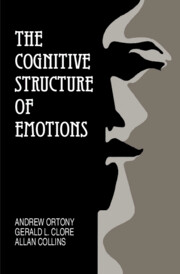Book contents
- Frontmatter
- Contents
- Preface
- 1 Introduction
- 2 The Structure of the Theory
- 3 The Cognitive Psychology of Appraisal
- 4 Factors Affecting the Intensity of Emotions
- 5 Reactions to Events: I
- 6 Reactions to Events: II
- 7 Reactions to Agents
- 8 Reactions to Objects
- 9 The Boundaries of the Theory
- References
- Author Index
- Subject Index
3 - The Cognitive Psychology of Appraisal
Published online by Cambridge University Press: 01 June 2011
- Frontmatter
- Contents
- Preface
- 1 Introduction
- 2 The Structure of the Theory
- 3 The Cognitive Psychology of Appraisal
- 4 Factors Affecting the Intensity of Emotions
- 5 Reactions to Events: I
- 6 Reactions to Events: II
- 7 Reactions to Agents
- 8 Reactions to Objects
- 9 The Boundaries of the Theory
- References
- Author Index
- Subject Index
Summary
One of the most salient aspects of the experience of emotions is that they vary a great deal in intensity both within and between people. This means that a theory of emotion must address the question of what determines intensity. Our general view is that the intensity of emotions is influenced by a number of variables, all of which are present in the construal of the situation that gives rise to the emotion in the first place. Thus, in order to address the question of intensity, we first need to consider the mechanism whereby emotion-inducing stimuli are appraised. This will provide us with the background we need to properly approach the intensity question. In the first part of this chapter we discuss the macrostructure of the knowledge representation system that we assume in order to deal with the appraisal issue. This we call the “appraisal structure.” In the second part, we use this system to show how the three central intensity variables of the theory can be explained. These variables are desirability, praiseworthiness, and appealingness, and they correspond to the three foci of valenced reactions, namely, events, agents, and objects.
The Appraisal Structure
Most of the things that people do are motivated. People rarely engage in random actions devoid of goals and purposes. In some sense, therefore, people must have a structure of goals, interests, and beliefs that underlie their behavior.
- Type
- Chapter
- Information
- The Cognitive Structure of Emotions , pp. 34 - 58Publisher: Cambridge University PressPrint publication year: 1988



